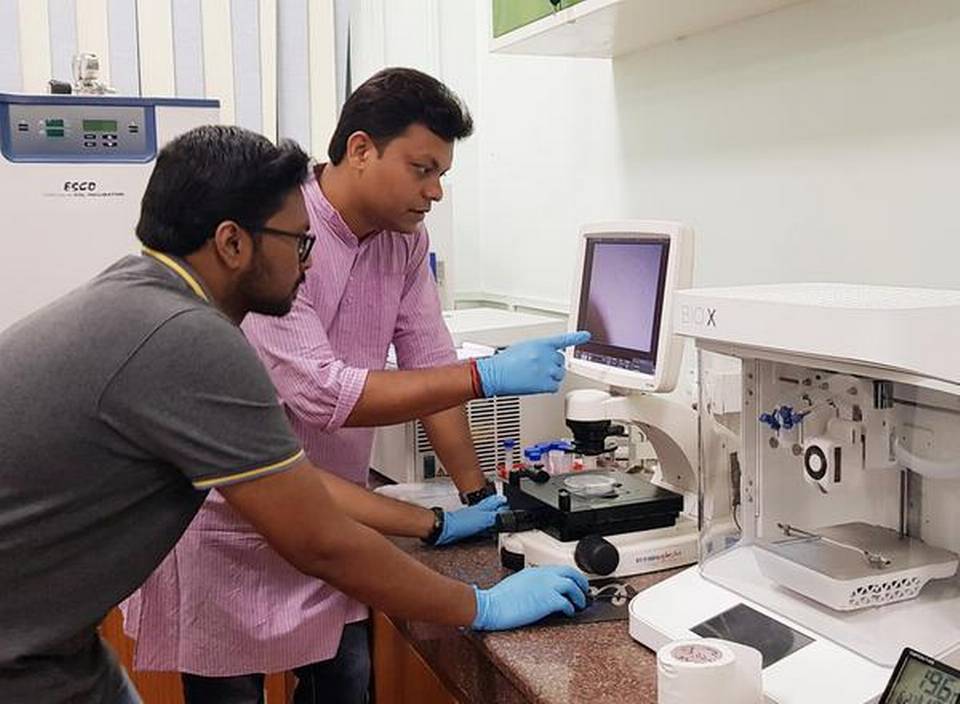by R Prasad
A scaffold made of silk–bone cement composite doped with silicon and zinc metal ions has been found to regenerate new bone tissue in rabbits in three months. The newly formed bone forms a seamless joint with the existing bone and has blood vessels inside it. Tests carried out on rabbits with defective thigh bone (femur) showed extensive bone formation of 73% at the end of 90 days compared with 49% in the case of scaffold made only of silk fibre. Even at the end of 30 days, there was adequate bone regeneration and new blood vessel formation.
Superior graft
The bone graft fabricated and tested by researchers at the Indian Institute of Technology (IIT) Guwahati is superior to currently available ones, affordable and does not require external use of growth factors for bone cells to grow.
“At the end of three months, the silk fibre had completely degraded leaving behind a homogeneous bone produced by rabbit bone cells. The newly formed bone had healed the defective femur,” says Prof. Biman Mandal from the Department of Biosciences and Bioengineering, IIT Guwahati who led the team. The bone cement made of calcium phosphate becomes a part of the bone while the biocompatible metal ions (silicon and zinc) get leached out at the end of 90 days.
The team is now validating the bone graft in large animals for clinical translation.
The scaffold is fabricated by first doping the bone cement with silicon and zinc and mixing the bone cement with chopped mulberry silk fibre. The bone cement gets adsorbed on the silk fibre. Liquid silk fibre is then added to bind the chopped fibre and bone cement; the liquid silk also makes the composite highly porous. The silk–bone cement composite has higher density and strength, more surface area and high surface roughness, closely resembling a native bone.
“The zinc and silicon ions get leached from the composite and activate bone and blood vessel cells. This leads to faster regeneration of the bone tissue and blood vessel formation,” says Prof. Mandal. “By doping with these metal ions we are doing away with external addition of growth factor and also making the graft affordable.”
“While the silk scaffold provides the physical cues, the silicon and zinc metal ions provide the chemical cues. These two synergistically mimic the biological cues which people use for tissue engineering,” explains Joseph Christakiran Moses from the Department of Biosciences and Bioengineering, IIT Guwahati and first author of a paper published in the journal ACS Biomaterials Science & Engineering.
Explaining how new blood vessels are formed, Moses says: “Silicon and zinc trigger a molecular response within the bone cells which makes them feel that they are lacking oxygen (triggering hypoxia response element). So the bone cells start secreting pro-blood vessel forming (angiogenic) signals leading to vascularisation.”
Bone regeneration
The compressive strength of silk fibre is about 40 kPa, while it is nearly double in the case of the silk–bone cement composite. Though doping with the silicon and zinc metal ions reduces the mechanical properties, particularly the compressive strength, the bulk strength of the doped composite is sufficient to activate bone regeneration.
Through in vitro studies carried out prior to experimentation with rabbits, the researchers realised that incorporation of bone cement and metal ion doped bone cement enhanced the bone tissue regeneration capacity.
While the composite was seeded with bone cells for in vitro studies, in rabbits, the composite was used without adding any bone cells. “Bone cells from neighbouring tissue migrate and bind to the scaffold and aid in bone regeneration,” Prof. Mandal says. The high porosity allows the bone cells to migrate and occupy the insides of the composite and regenerate the tissue, while the surface roughness of the composite, which closely mimics the native bone, facilitates faster and better regeneration of the bone.(Source: The Hindu)

